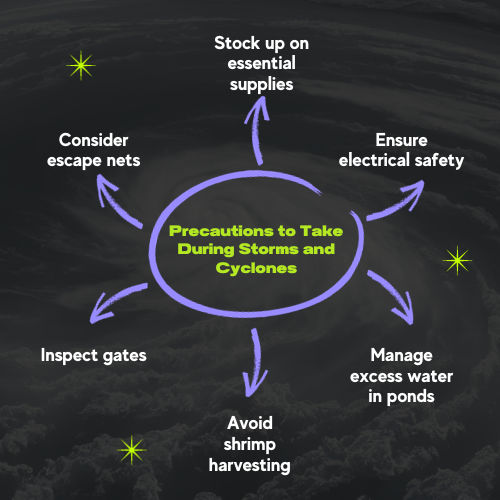Shrimp farming is a growing industry not only in coastal areas but also in inland rivers. However, shrimp farming is subject to risks from various forces of nature. Cyclones, in particular, can cause immense damage to shrimp farms and ultimately ruin the livelihoods of farmers and people working in the industry.
Therefore, it is necessary to take precautionary steps to guard against these storms. Cyclone prediction and warning systems can prevent the loss of life, but for protecting the farms, it is essential to design and build storm-resistant farms. In this blog post, we will explore ways to shield your shrimp farm from cyclones.
Proper planning and design of shrimp farms are crucial for their long-term sustainability and protection against cyclones. Farms located in regions prone to cyclones should be constructed with elevated embankments and deepening of ponds to prevent overspill. Farms should also consider installing a suitable drainage system to prevent water accumulation in case of heavy rainfall during cyclone seasons.
The environment surrounding your shrimp farm can also serve as a protective shield against the effects of cyclones. The planting of vegetation such as mangroves, which is a natural barrier that helps protect shorelines from storm waves, can serve as a buffer zone that reduces the impact of strong winds and storm surges to the dykes on your shrimp farm.
Managing water within the farm during a cyclone is a critical task. Cyclones can increase the water levels in ponds much faster than pumps can accommodate. Hence, it's necessary to ensure that the farm's drainage and intake system can cope with the excess volume of water. Overflow channels and protecting gates can be installed to release excess water from ponds to prevent overwhelming the pumps
Shrimp farms require a sophisticated system of equipment, such as aerators, feeders, and pumps, to sustain the shrimp's growth and health. It is important to have a backup power supply and backup pumps that can start immediately if the primary pumps are out of service due to cyclones. Keeping these backups functioning is critical to preventing the loss of shrimp stocks.
Preparing a disaster response plan for your shrimp farm is crucial to minimize damage to your farm and also to the stock in the event of a cyclone. It's essential to have measures in place to protect people, animals, and infrastructure. The emergency response plan should involve taking the necessary steps to minimize the loss of crops, including evacuating shrimp and restocking once the cyclones have passed.

Here are some important measures to keep in mind:
Stock up on essential supplies: Prior to the storm, make sure to gather all necessary items on your farm. These may include food, diesel for generators, spare parts for aerators, feed, DO tablets, agricultural lime for adjusting pH levels, rubber gloves, rain coats, torches, batteries, food for the workers, essential medicines for staff and more.
Ensure electrical safety: Check for any loose power lines and make sure changeover and generator are in good condition. It is vital to have proper wire connections around the farm, ensuring there are no loose ends. Cover starters adequately to prevent water seepage to electrical lines.
Manage excess water in ponds: Monitor water levels in ponds and ensure that excess water can escape through the outlet. This helps prevent flooding and potential damage.
Avoid shrimp harvesting: During storms and cyclones, it is advisable to refrain from harvesting shrimp. This protects both the workers and the shrimp from any potential harm.
Inspect gates: Regularly check all inlet and outlet gates to ensure they are in proper working condition. This helps prevent any damage that may occur during the storm.
Consider escape nets: If feasible, it is recommended to install escape nets. These nets can act as a safety measure by containing any escaped shrimp within the nets, minimizing potential losses.
Aeration: Ensure that aerators are operated to ensure mixing of surface waters with bottom waters.
With these practical considerations in mind, it is of utmost importance that shrimp farmers must invest in appropriate measures to protect their farms from the potential health and economic risks associated with cyclones. The comprehensive plan adopted by the farmers should take necessary infrastructure, appropriate ponds, vegetation, water management practices, and emergency response measures into consideration to ensure utmost safety and sustainability.
Protecting your shrimp farm is not an impossible task but an achievable blueprint if executed diligently. Aquabeats provides extensive resources and support services allowing shrimp farmers to manage cyclones effectively and protect their livelihoods along with their shrimps. To get started, checkout our website www.aquabeats.in for detailed guidance on modern methods to survive cyclone threats. So, make sure you brace yourself ahead of forecasted storms and trust Aquabeats for assistance while you get prepared.